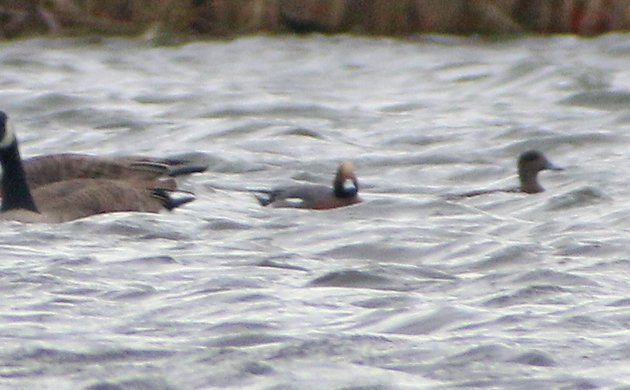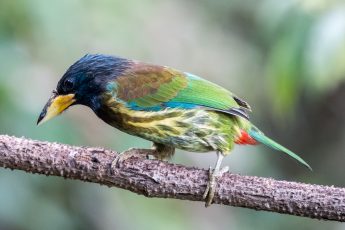Oktoberfest, a two week period in the first half of October, is perhaps the most anticipated time of the year for the South Florida birder. No, I am not referring to a Floridian spin-off of the world’s largest fair in Munich, Germany meant to celebrate everything beer. I am referring to the peak of autumn migration for neotropical migrants arriving on their wintering grounds or passing us by to the south. Before diving into Oktoberfest, however, a very brief introduction to the dynamics of landbird migration in Southeast Florida is in order.
Autumn migration gets off to an inauspicious start in Miami-Dade with the appearance of a small selection of passerines at local migrant traps at mid-July. A visit to A.D. Barnes Park will usually yield sightings of Louisiana Waterthrush, Red-eyed Vireo, and Yellow-throated Warbler during this time period. August continues the theme of low diversity and numbers, with only a smattering of new species in addition to those mentioned above such as Yellow-throated Vireo and Worm-eating Warbler. By the time September rolls around, anything is possible, the raptors begin to join the passerines on their own migratory journey, and birders begin to pour into suburban migrant traps in search of such treasures as Kentucky and Swainson’s Warblers which they cannot see at any other time of year. However, the really big numbers do not begin until October.
A fall Cape May Warbler, by Carlos Sanchez
Oktoberfest is the term coined by birders in Miami-Dade county to refer to a time of plenty [of migrants], when a visit to a local suburban park might yield up to twenty or more species of warbler on a good day. The bulk of the numbers of many typically Caribbean wintering species such as Cape May Warbler, Black-throated Blue Warbler, and American Redstart migrate through the sunshine state in the first half of October. In addition, many species which typically utilize different migration routes in the spring and winter further west in Mesoamerica such as Chestnut-sided, Blackburnian, and Tennessee Warbler briefly appear in small numbers at migrant traps for birders to enjoy. Larger passerines choosing a more eastern migration route such as Catharus thrushes, orioles, tanagers, and grosbeaks also fall into this category. Birders in South Florida might have to wait until next October to have a chance at seeing these birds again. In addition, raptors such as Broad-winged Hawk, Sharp-shinned Hawk, Peregrine Falcon, and Merlin can often be seen soaring high overhead in a steady stream on bright sunny days or perched inside a tropical hardwood hammock plucking the feathers off an unlucky migrant. For the birder, times are good, but October has the potential to be even better.
A male Black-throated Blue Warbler, by Judd Patterson
The combination of deep tropical moisture coming up from the northwest Caribbean and the first deep cold fronts of the season digging south through the state results in a lot of persistent precipitation in October for South Florida. Like a tag team, cold fronts encourages migrants to take off behind them due to the favorable winds aloft while the tropical moisture slowly pushing up from the south creates a blockade. This situation means there is a higher than normal potential for — not quite a fallout — a sort of logjam of migrants forced to stop at the tip of the peninsula to wait for better flying conditions. Many strong fliers, such as thrushes and some warblers, are only seen in large numbers when such a rain event forces them down.
Mostly seen during autumn passage, a Swainson’s Thrush by Judd Patterson
One such event happened in October of 2011 when birders were reporting incredible numbers of migrants temporarily marooned at migrant traps such as A.D. Barnes and Bill Baggs State Park. A correctly angled cold front combined with a sloppy, wet tropical system created the right conditions for a logjam. There were reports of people seeing twenty or more species of warbler at a single site, with staggering numbers in the hundreds of Yellow-billed Cuckoo, Indigo Bunting, Black-throated Blue Warbler, and American Redstart. Most impressive was the sheer number of the usually rare Bay-breasted Warbler — many long time birders saw more of this species than they have in their entire birding careers in Florida! These conditions lasted for several days, allowing birders ample time to get out and enjoy these birds. Once the cold front finally managed to push past Miami and sweep away the moisture, neotropical migrants took advantage of the clear skies, and the following day, there was no trace of what had happened in the days prior.
Will October 2012 have the right conditions for a repeat of 2011? Even if migrants do not pile up at suburban parks as they did in 2012, Oktoberfest will still remain as one of the best and most exciting times to be a birder in South Florida. For residents at the southern tip of the state, I can think of no better time to take your binoculars to the local park and marvel at which little travelers have chosen to refuel there so that they may continue their journey.









 New writers welcome – please contact us for details.
New writers welcome – please contact us for details.

















As a German birder, I must say that I am far more likely to visit the Floridian version of the Oktoberfest than the Munich one. Thanks for the great post!!
Thanks for the informative post Carlos. I’ll be in Key West/Dry Tortugas next month, pretty stoked for migration!
Yea, I remember that time last year. the amount of yb cuckoos at Cape Florida was phenomenal, I easily saw 100s that day. They actually were a nuisance (!), constantly crashing around, scaring away other birds- I had a beautiful male summer tanager, then the cuckoo landed practically on top of it- away it went! Also 3 scarlet tanagers on one branch, all inches from each other was pretty sweet too. Good times…